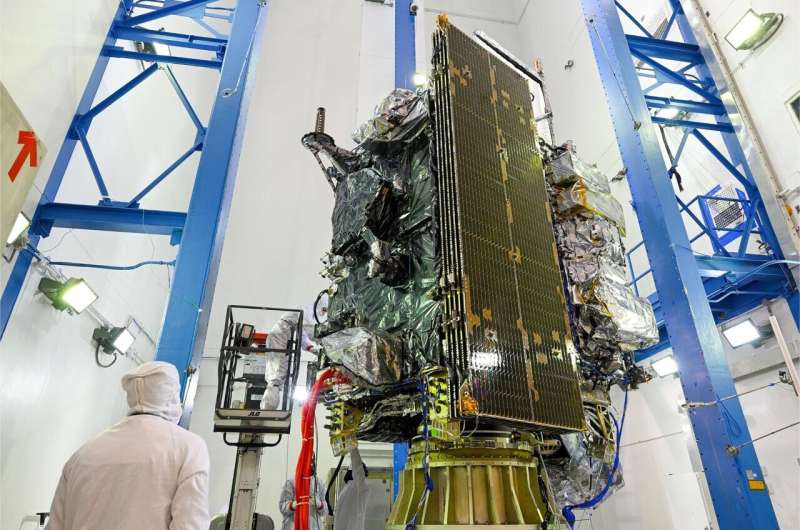This article has been reviewed according to Science X's editorial process and policies. Editors have highlighted the following attributes while ensuring the content's credibility:
fact-checked
trusted source
proofread
NOAA's GOES-U completes environmental testing

GOES-U, the fourth and final satellite in NOAA's GOES-R Series of advanced geostationary satellites, recently completed rigorous testing to ensure it can withstand the harsh conditions of launch and orbiting in space 22,236 miles above Earth.
The testing process spanned nearly a year. During thermal vacuum testing, completed in November 2022, GOES-U was placed in a large 29-foot wide by 65-foot deep (9 meter by 20 meter) chamber and subjected to a vast range of temperatures, soaring as high as 188 degrees Fahrenheit (87 degrees Celsius) and dropping as low as minus 67 degrees Fahrenheit (minus 55 degrees Celsius) to simulate the extreme temperatures of launch and the space environment.
In February 2023, GOES-U completed vibration testing, which mimics the stresses it will experience during launch to ensure the satellite doesn't have structural weaknesses. GOES-U then endured the extremely high sound pressure of 138.4 decibels from high-intensity horns during acoustic testing. This testing simulated the noises GOES-U will be subjected to when it is launched.
GOES-U completed shock testing in March 2023. This testing confirmed the satellite will be able to withstand the shocks encountered during separation from the launch vehicle and deployment of the satellite's solar panels.
Electromagnetic interference and electromagnetic compatibility (EMI/EMC) testing, conducted in August 2023, concluded the environmental testing program. EMI/EMC testing ensures that spacecraft functions are not affected by various types of electromagnetic radiation during operations.
The GOES-U team also conducted a solar array deployment test, which verified that the satellite's large, five-panel solar array—which is folded up when the satellite is launched—will properly deploy when GOES-U reaches geostationary orbit.
The deployed solar panels will form a single solar array wing that will rotate once per day to continuously point its photovoltaic (solar) cells toward the sun. The photovoltaic cells will convert energy from the sun into electricity to power the entire satellite, including the instruments, computers, data processors, sensors, and telecommunications equipment.
These tests confirmed the GOES-U satellite and all of its instruments can withstand the launch and maintain functionality in orbit. Lockheed Martin and SpaceX personnel conducted the testing at the Lockheed Martin facility in Littleton, Colorado, where the satellite was built.
While the satellite was being tested to prepare it for the physical conditions of launch and space, the GOES-U mission operations team began critical activities to rehearse launch procedures and test communications between the satellite and ground system.
The mission operations team is performing end-to-end tests that command the satellite from the ground system in Maryland. The end-to-end tests validate the compatibility of space and ground hardware, software, and communications interfaces in a mission operations context.
Most recently, the team conducted testing to verify commands with the new Compact Coronagraph-1 (CCOR-1) instrument. CCOR-1 is a new space weather instrument that will fly on GOES-U and image the solar corona (the outer layer of the sun's atmosphere) to detect and characterize coronal mass ejections (CMEs). CCOR-1 is part of NOAA's Space Weather Follow On mission.
The mission operations team recently began a series of mission rehearsals, which use a satellite simulator and the ground system to train operations personnel and test the readiness of operational products and the ground system.
These rehearsals help to test different parts of launch, like orbit-raising, post-launch separation events, solar array deployment, and propulsion system readiness. They simulate both normal operations and what to do if a procedure doesn't go as planned.
GOES-U is on track for an April 2024 launch from Cape Canaveral Space Force Station in Florida aboard a Falcon Heavy launch vehicle. The satellite will be renamed GOES-19 once it reaches geostationary orbit, approximately two weeks after launch. GOES-19 will then undergo an on-orbit checkout of its instruments and systems, followed by validation of the satellite's data products.
NOAA's GOES-R Series is the Western Hemisphere's most advanced weather-observing and environmental-monitoring system. The GOES-R Series Program is a four-satellite mission that includes GOES-R (GOES-16, launched in 2016, now operating as GOES East), GOES-S (GOES-17, launched in 2018, now serving as an on-orbit standby), GOES-T (GOES-18, launched in 2022 and operating as GOES West) and GOES-U.
The satellites provide critical data for weather forecasts and warnings, detection and monitoring of environmental hazards like fire, smoke, fog, volcanic ash, and dust, and monitoring of solar activity and space weather.
The GOES-R Series satellites are planned for operation into the 2030s. Meanwhile, NOAA and NASA are working on the next-generation geostationary satellite mission called Geostationary Extended Observations (GeoXO). GeoXO will continue the observations provided by GOES-R and also bring new capabilities to address major environmental challenges of the future in support of U.S. weather, ocean and climate operations.
The GOES-R and GeoXO Programs are collaborative efforts between NOAA and NASA. NOAA funds and manages the program, operates the satellites, and distributes satellite data products to users worldwide. NASA and commercial partners develop and build the spacecraft and instruments and launch the satellites.
Provided by NASA





















